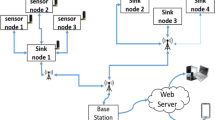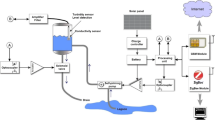Abstract
The measurement of physicochemical variables to infer water quality is important since they help determine the distribution and abundance of aquatic organisms or pollution-related problems. Recently, the development of low-cost probes is a suitable alternative for continuous monitoring of these variables rather than the use of expensive instruments. In this work, a low-cost multiparameter probe (LCMP) has been developed to monitor water quality in an estuary located in Northwestern Mexico during a 3-month period. The LCMP integrates different sensors to an Arduino Nano microcontroller allowing to measure electrical conductivity, dissolved oxygen, pH, salinity, water temperature, and tide level. Data files were stored in a data logger system consisting of a secure digital (SD) card module and a real-time clock module coupled to the Arduino microcontroller. To ensure continuous operation, the system was powered by four 3.7 V, 10,000 mAh rechargeable LiPo batteries. All LCMP components were encapsulated in a polyvinyl chloride pipe. The results show that the LCMP had a good agreement with a commercial-grade multiparameter probe and was able to monitor continuously in hourly time steps. Finally, the LCMP proved to be an alternative for the establishment of coastal observatories, which has been deficient due to limited funding.











Similar content being viewed by others
References
Abbasi, T., & Abbasi, S. A. (2012). Water quality indices (p. 384). Amsterdam: Elsevier..
Adams, J. B. (2014). A review of methods and frameworks used to determine the environmental water requirements of estuaries. Hydrological Sciences Journal, 59(3–4), 451–465.
Al Dahaan, S., Al-Ansari, N., & Knutsson, S. (2016). Influence of groundwater hypothetical salts on electrical conductivity total dissolved solids. Engineering, 8(11), 823–830.
Bate, G. C., Whitfield, A. K., Adams, J. B., Huizinga, P., & Wooldridge, T. H. (2002). The importance of the river-estuary interface (REI) zone in estuaries. Water SA, 28(3), 271–280.
Beddows, P. A., & Mallon, E. K. (2018). Cave pearl data logger: a flexible Arduino-based logging platform for long-term monitoring in harsh environments. Sensors, 18(2), 530.
Borja, Á., Dauer, D. M., & Grémare, A. (2012). The importance of setting targets and reference conditions in assessing marine ecosystem quality. Ecological Indicators, 12(1), 1–7.
Bugica, K., Sterba-Boatwright, B., & Wetz, M. S. (2020). Water quality trends in Texas estuaries. Marine Pollution Bulletin, 152, 110903.
Cressey, D. (2013) Crowdsourcing may open up ocean science. Nature News, Springer Nature.
Cude, C. G. (2001). Oregon water quality index, a tool for evaluating water quality management effectiveness. JAWRA Journal of the American Water Resources Association, 37(1), 125–137.
Cyrus, D. P., & Martin, T. J. (1991). The importance of estuaries in life histories of flatfish species on the southern coast of Africa. Netherlands Journal of Sea Research, 27(3–4), 255–260.
Defe, G. A., & Antonio, A. Z. C. (2018). Multi-parameter water quality monitoring device for grouper aquaculture. In 2018 IEEE 10th International Conference on Humanoid, Nanotechnology, Information Technology, Communication and Control, Environment and Management (HNICEM) (pp. 1-5). IEEE.
Delauney, L., Compere, C., & Lehaitre, M. (2010). Biofouling protection for marine environmental sensors. Ocean Science, 6(2), 503–511.
Demetillo, A. T., Japitana, M. V., & Taboada, E. B. (2019). A system for monitoring water quality in a large aquatic area using wireless sensor network technology. Sustainable Environment Research, 29(1), 12.
Divić, V., Galešić, M., Dato, M. D., Tavra, M., & Andričević, R. (2020). Application of open source electronics for measurements of surface water properties in an estuary: a case study of river Jadro, Croatia. Water, 12(1), 209.
Dunnette, D. A. (1979). A geographically variable water quality index used in Oregon. Journal - Water Pollution Control Federation, 51, 53–61.
Gardner, R. C., & Davidson, N. C. (2011). The Ramsar convention. In In Wetlands (pp. 189–203). Dordrecht: Springer.
Gikas, G. D., Yiannakopoulou, T., & Tsihrintzis, V. A. (2006). Water quality trends in a coastal lagoon impacted by non-point source pollution after implementation of protective measures. Hydrobiologia, 563(1), 385–406.
Glasgow, H. B., Burkholder, J. M., Reed, R. E., Lewitus, A. J., & Kleinman, J. E. (2004). Real-time remote monitoring of water quality: a review of current applications, and advancements in sensor, telemetry, and computing technologies. Journal of Experimental Marine Biology and Ecology, 300(1–2), 409–448.
Horsburgh, J. S., Caraballo, J., Ramírez, M., Aufdenkampe, A. K., Arscott, D. B., & Damiano, S. G. (2019). Low-cost, open-source, and low-power: but what to do with the data? Frontiers in Earth Science, 7(67), 1.
Howes, T., Lemckert, C., & Moss, A. (2002). Long term monitoring of estuarine water quality: Brisbane River turbidity. Water, 29(6), 37–39.
Kumar, D., & Alappat, B. J. (2009). NSF-water quality index: does it represent the experts’ opinion? Practice Periodical of Hazardous, Toxic, Waste Management, 13(1), 75–79.
Latimer, J. S., Boothman, W. S., Pesch, C. E., Chmura, G. L., Pospelova, V., & Jayaraman, S. (2003). Environmental stress and recovery: the geochemical record of human disturbance in New Bedford Harbor and Apponagansett Bay, Massachusetts (USA). The Science of the Total Environment, 313, 153–176.
Lithgow, D., Esteves, L. S., Martínez, M. L., Martell, R., Rivillas, G. D., Winckler, P., Osorio-Cano, J. D., Moreno-Casaso-la, P., Osorio, A. F., Mendoza, E., Pereira, P., Campos, A., Castillo-Campos, G.. Castillo-Campos y Silva, R. (2017). Las zonas costeras ante el cambio climático: la infraestructura verde como estrategia para disminuir la vulnerabilidad de la costa de latinoamérica. p. 465-476. En : Botello A.V., S.Villanueva, J. Gutiérrez y J.L. Rojas Galaviz (eds.). Vulnerabilidad de las zonas costeras de Latinoamérica al cambio climático.
Lockridge, G., Dzwonkowski, B., Nelson, R., & Powers, S. (2016). Development of a low-cost arduino-based sonde for coastal applications. Sensors, 16(4), 528.
Mao, F., Khamis, K., Krause, S., Clark, J., & Hannah, D. M. (2019). Low-cost environmental sensor networks: recent advances and future directions. Frontiers in Earth Science, 7, 221. https://doi.org/10.3389/feart.2019.00221.
MATLAB and Statistics Toolbox Release. (2016). The MathWorks. Natick: Incorporated.
McRoberts, M. (2013). Beginning Arduino. Apress, 424 pages.
Mitra, S., Ghosh, S., Satpathy, K. K., Bhattacharya, B. D., Sarkar, S. K., Mishra, P., & Raja, P. (2018). Water quality assessment of the ecologically stressed Hooghly River estuary, India: a multivariate approach. Marine Pollution Bulletin, 126, 592–599.
Morales-Pérez, R. A., & Gutiérrez de Velasco, G. (1989). Marea en el Golfo de California. Geofísica internacional, 28(1), 25–46.
O’Boyle, S., McDermott, G., Noklegaard, T., & Wilkes, R. (2013). A simple index of trophic status in estuaries and coastal bays based on measurements of pH and dissolved oxygen. Estuaries and Coasts, 36(1), 158–173.
Parra, L., Sendra, S., García, L., & Lloret, J. (2018). Design and deployment of low-cost sensors for monitoring the water quality and fish behavior in aquaculture tanks during the feeding process. Sensors, 18(3), 750.
Tyagi, S., Sharma, B., Singh, P., & Dobhal, R. (2013). Water quality assessment in terms of water quality index. american. Journal of Water Resources, 1(3), 34–38.
Vega, X., González, M. A., Muñoz del Viejo, A., Boere, G., Galbraith, C., & Stroud, D. (2006). Potential new Ramsar sites in Northwest Mexico: strategic importance for migratory waterbirds and threats to conservation (pp. 158–160). Edinburgh: Waterbirds around the world. The Stationery Office.
Williams, D. E. (2019). Low cost sensor networks: how do we know the data are reliable? ACS sensors, 4(10), 2558–2565.
Wylie, S. A., Jalbert, K., Dosemagen, S., & Ratto, M. (2014). Institutions for civic technoscience: how critical making is transforming environmental research. The Information Society, 30(2), 116–126.
Zhang, D., Heery, B., O’Neil, M., Little, S., O’Connor, N. E., & Regan, F. (2019). A low-cost smart sensor network for catchment monitoring. Sensors, 19(10), 2278.
Zulkifli, S. N., Rahim, H. A., & Lau, W. J. (2018). Detection of contaminants in water supply: a review on state-of-the-art monitoring technologies and their applications. Sensors and Actuators B: Chemical, 255, 2657–2689.
Acknowledgments
We would also like to thank Eduardo Mendívil-Alvarez and Karol Granados for their support and help in all field activities.
Funding
We received support from the Mexican National Council for Science and Technology (CONACYT) through the funded project National Laboratory of Coastal Resilience (Grant LN-293354 and LN-299063). Additional funding was provided by PROFAPI-ITSON 2019-0118 and 2019-186.
Author information
Authors and Affiliations
Corresponding author
Additional information
Publisher’s note
Springer Nature remains neutral with regard to jurisdictional claims in published maps and institutional affiliations.
Rights and permissions
About this article
Cite this article
Méndez-Barroso, L.A., Rivas-Márquez, J.A., Sosa-Tinoco, I. et al. Design and implementation of a low-cost multiparameter probe to evaluate the temporal variations of water quality conditions on an estuarine lagoon system. Environ Monit Assess 192, 710 (2020). https://doi.org/10.1007/s10661-020-08677-5
Received:
Accepted:
Published:
DOI: https://doi.org/10.1007/s10661-020-08677-5




